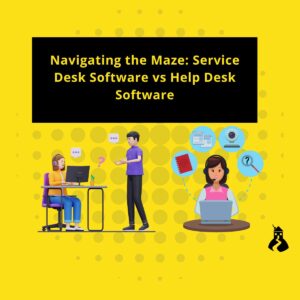
Two terms often used interchangeably are Service Desk Software and Help Desk Software. While both are integral components of a well-structured IT support system, understanding their nuanced differences is crucial for organizations striving to streamline their operations and enhance customer satisfaction. In this blog post, we’ll delve into the distinctions between Service Desk Software and Help Desk Software, shedding light on their unique functionalities and the specific roles they play in IT service management.
Help Desk Software VS Service Desk Software Defining the Basics
Let’s start by defining the fundamental aspects of each term.
Help Desk Software: Help Desk Software is primarily designed to address and resolve specific issues reported by end-users or customers. It acts as a centralized platform for logging and tracking user-generated tickets, managing incoming requests efficiently, and ensuring timely resolutions. Help desks are reactive in nature, responding to incidents and service requests promptly.
Service Desk Software: On the other hand, the Service Desk option offers a broader spectrum of functionalities. It not only handles incident management but also encompasses service request management, change management, problem management, and more. Service desks are proactive, aiming to improve overall service quality and prevent potential issues by taking a holistic approach to IT service management.
Key Differences
Now, let’s explore their key differences
Scope of Functionality:
Help Desk Software: Focuses on incident resolution and service request management.
Service Desk Software: Encompasses a wider range of ITSM processes, including incident, problem, change, and asset management.
User-Centric vs Service-Centric:
Help Desk Software: Primarily user-centric, addressing individual issues.
Service Desk Software: Service-centric, focusing on the overall health and performance of IT services.
Proactive vs Reactive Approach:
Help Desk Software: Reactive, responding to issues as they arise.
Service Desk Software: Proactive, aiming to prevent issues and enhance the overall IT service quality.
Integration and Collaboration:
Help Desk Software: Often involves basic integrations and collaboration features.
Service Desk Software: Offers advanced integrations, collaboration tools, and a more comprehensive approach to IT service delivery.
Choosing the Right Solution:
Selecting the appropriate solution depends on the organization’s specific needs, size, and objectives. Smaller organizations with straightforward support requirements may find Help Desk Software sufficient, while larger enterprises with complex IT environments and a focus on service improvement may benefit more from the comprehensive capabilities of Service Desk Software.
Conclusion:
In conclusion, while they share common goals in ensuring efficient IT support, their differences lie in scope, approach, and functionality. By understanding these distinctions, organizations can make informed decisions that align with their IT service management goals, contributing to a more agile, responsive, and customer-centric IT environment.
Learn more about our services.





